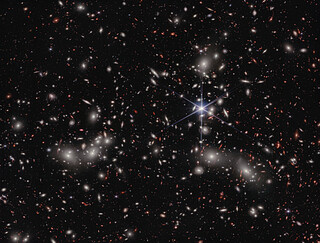weic2305 — Photo Release
Webb Uncovers New Details in Pandora’s Cluster
15 February 2023
Astronomers have revealed the latest deep-field image from the NASA/ESA/CSA James Webb Space Telescope, featuring never-before-seen details in a region of space known as Pandora’s Cluster (Abell 2744). Webb’s view displays three clusters of galaxies — already massive — coming together to form a megacluster. The combined mass of the galaxy clusters creates a powerful gravitational lens, a natural magnification effect of gravity, allowing much more distant galaxies in the early Universe to be observed by using the cluster like a magnifying glass.
Only Pandora’s central core has previously been studied in detail by the NASA/ESA Hubble Space Telescope. By combining Webb’s powerful infrared instruments with a broad mosaic view of the region’s multiple areas of lensing, astronomers aimed to achieve a balance of breadth and depth that will open up a new frontier in the study of cosmology and galaxy evolution.
Astronomers studied the region as part of the Ultradeep NIRSpec and NIRCam ObserVations before the Epoch of Reionization (UNCOVER) programme. The new view of Pandora’s Cluster stitches four Webb snapshots together into one panoramic image, displaying roughly 50 000 sources of near-infrared light.
In addition to magnification, gravitational lensing [1] distorts the appearance of distant galaxies, so they look very different from those in the foreground. The galaxy cluster 'lens' is so massive that it warps the fabric of space itself, enough for light from distant galaxies that passes through that warped space to also take on a warped appearance.
In the lensing core to the lower right in the Webb image, which has never been imaged by Hubble, Webb revealed hundreds of distant lensed galaxies that appear like faint arced lines in the image.
The UNCOVER team used Webb’s Near-Infrared Camera (NIRCam) to capture the cluster with exposures lasting 4–6 hours, for a total of about 30 hours of observing time. The next step is to meticulously go through the imaging data and select galaxies for follow-up observation with the Near-Infrared Spectrograph (NIRSpec), which will provide precise distance measurements, along with other detailed information about the lensed galaxies’ compositions, providing new insights into the early era of galaxy assembly and evolution. The UNCOVER team expects to make these NIRSpec observations in the summer of 2023.
In the meantime, all of the NIRCam photometric data have been publicly released so that other astronomers can become familiar with them and plan their own scientific studies with Webb’s rich datasets.
The imaging mosaics and catalogue of sources on Pandora’s Cluster (Abell 2744) provided by the UNCOVER team combine publicly available Hubble data with Webb photometry from three early observation programmes: JWST-GO-2561, JWST-DD-ERS-1324, and JWST-DD-2756.
Notes
[1] Gravitational lensing occurs when a massive celestial body — such as a galaxy cluster — causes a sufficient curvature of spacetime for the path of light around it to be visibly bent, as if by a lens. The body causing the light to curve is accordingly called a gravitational lens. According to Einstein’s general theory of relativity, time and space are fused together in a quantity known as spacetime. Within this theory, massive objects cause spacetime to curve, and gravity is simply the curvature of spacetime. As light travels through spacetime, the theory predicts that the path taken by the light will also be curved by an object’s mass. Gravitational lensing is a dramatic and observable example of Einstein's theory in action. Extremely massive celestial bodies such as galaxy clusters cause spacetime to be significantly curved. In other words, they act as gravitational lenses. When light from a more distant light source passes by a gravitational lens, the path of the light is curved, and a distorted image of the distant object.
More information
Webb is the largest, most powerful telescope ever launched into space. Under an international collaboration agreement, ESA provided the telescope’s launch service, using the Ariane 5 launch vehicle. Working with partners, ESA was responsible for the development and qualification of Ariane 5 adaptations for the Webb mission and for the procurement of the launch service by Arianespace. ESA also provided the workhorse spectrograph NIRSpec and 50% of the mid-infrared instrument MIRI, which was designed and built by a consortium of nationally funded European Institutes (The MIRI European Consortium) in partnership with JPL and the University of Arizona.
Webb is an international partnership between NASA, ESA and the Canadian Space Agency (CSA).
Image Credit: NASA, ESA, CSA, I. Labbe (Swinburne University of Technology), R. Bezanson (University of Pittsburgh), A. Pagan (STScI)
Links
Contacts
Bethany Downer
ESA/Webb Chief Science Communications Officer
Email: [email protected]
Ninja Menning
ESA Newsroom and Media Relations Office
Email: [email protected]
About the Release
| Release No.: | weic2305 | |
|---|---|---|





